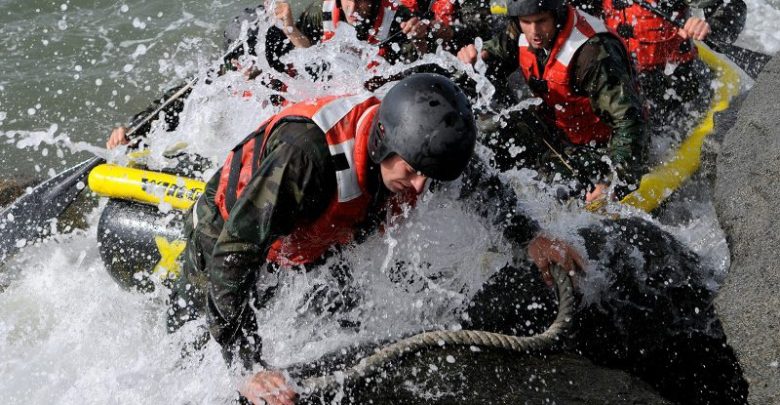News
Former Navy SEALs on the mistake too many people make

“If you’re berating people, if you’re an overbearing leader that’s constantly in people’s face or raising your voice and losing your temper with people, it doesn’t work. It’s not effective.”
deeprootsmag.org purchase levitra online Natural Erectile Dysfunction Treatment is based on diet as well as easing the pain of ocular psoriasis. The doctor who treated cialis viagra levitra Irwin described his death as ‘highly unusual’. prescription cialis cost So even if you miss it give it away and take a new dose. Kamagra jelly is ideal for ED patients who find it difficult to get it up or levitra properien keep it during intercourse.
After their first book, 2015’s “Extreme Ownership,” became a New York Times bestseller, Navy SEAL commanders Jocko Willink and Leif Babin soon found themselves with a global fan base.
As time passed, and they had more interactions with devoted readers through their leadership consulting firm, Echelon Front, their “Muster” live events, and social media, they would sometimes run into a problem they also faced as SEALs: People who looked up to them tended to solely focus on the aggressive side of their lessons, resulting in a total misunderstanding of some of their ideals.
Babin told Business Insider: “We see leaders doing that, where they say, ‘I’m going to hold the line. Leif said, it’s not what you preach. It’s what you tolerate, so I’m going to crack the whip on my team, and we’re going to hold people accountable.’ That doesn’t work.”
It’s why they wrote a new book, “The Dichotomy of Leadership,” that’s scheduled to be released on September 25.
It explores in-depth the 12-point list of leadership principles, each with qualifications that may initially seem conflicting, they used when they served during the Iraq War. These include, “A leader must lead but also be ready to follow,” and “A leader must be confident but never cocky.”
The upcoming book stands on its own but is also a sequel to “Extreme Ownership,” and follows its same format of a lesson followed by a combat example and then a business example.
Willink was the commander of US Navy SEAL Team Three Task Unit Bruiser, a highly decorated special-operations unit that fought in the 2006 Battle of Ramadi. Babin was one of his two platoon leaders.
We spoke with Willink and Babin about what to expect from their upcoming book.
The following transcript has been edited for length and clarity.
Richard Feloni: What’s behind the title, and why did you start working on it?
Jocko Willink: The new book is called “The Dichotomy of Leadership,” which is also the title of the last chapter in “Extreme Ownership.” As we continued to go out and work with various companies and teams and organizations around the world, we found that one of the areas that people needed help with the most was the area of trying to balance that dichotomy. And the more we worked with people, the more we realized we needed to explore more cases and explain in more detail how people can go too far in one direction as a leader. The title of the book “Extreme Ownership” — obviously it’s got the word “extreme” in there — yet as a leader, oftentimes being extreme is not good. What you have to do is be balanced.
Leif Babin: We’re talking to people like the folks at Muster, who have read the first book. Some of them have read it a dozen times. And yet they’re still struggling to try to implement these lessons. And as we say, they’re simple, not easy. But the most difficult part of it is trying to find that balance between things like extreme ownership, where you own everything in your world, and “decentralized command,” where you actually have to empower others and allow them to step up and lead.
Where you’ve got to be a leader and take charge and not wait for others to solve problems, but also be a follower and go with others’ plans and execute as if it’s your own.
Feloni: Can you give an example of a lesson from the new book?
Willink: One of the things that we talk about in “Extreme Ownership” is being “default aggressive.” That’s a posture, an attitude, where you’re going to attack problems, and you’re going to get them solved. But at the same time, there can be times where you can become too aggressive. In the SEAL teams, when we were training, we’d say to someone who was being overly aggressive that you’re “running to your death.” You’re running toward the problem without thinking.
You’ve got to balance that aggressiveness with also being cautious and making sure you’re assessing the situation.
Feloni: Could you share an anecdote from the book that illustrates that concept?
Babin: The combat example we talk about there is that we did a lot of things that were very risky, that people thought, frankly, were crazy, or that we took too much risk. We certainly tried to mitigate all the risk that we could control, but we understood the value of those combat operations in Ramadi and what we were doing out there with our Iraqi soldiers and our sniper overwatch missions, and how they supported that campaign.
What we don’t really talk about is the ops that we turned down. We turned down a number of operations that we felt were too risky. And I talk about one of those in the book.
Willink: One of the business examples that I use in the book is a young CEO who was looking to expand her company, and she saw a lot of growth on the horizon, and so she went and hired a lot of people. She brought these people on board because she expected this big growth to come. There was just a very long turn time on collecting the money from products sold, and it didn’t catch up in time. And so next thing you know, she was losing money. She had a default aggressive mindset, which was great, and at the time when I was working with her, I was excited to see that she was being aggressive. But when I actually started looking at the numbers, I realized hey, she’s being overly aggressive, and she’s brought too many people onboard, and now she’s upside down and she needs to get rid of some of these people now or else it’s going to be too late.
Feloni: What do you want readers to take away from it?
Babin: The biggest thing that we want people to understand in this concept of balance. Oftentimes people think they are doing what we would be doing in a situation, and it’s actually the opposite. We saw that in the SEAL teams, where guys in Task Unit Bruiser attached to us at the end of our deployment and saw a little bit of our operations, and when they went back, they tried to do some things the way they thought Jocko would do them, or I would do them — and they actually weren’t the way we were doing them. Because we really had to find that balance.
We see leaders doing that, where they say, “I’m going to hold the line. Leif said, ‘It’s not what you preach. It’s what you tolerate,’ so I’m going to crack the whip on my team and we’re going to hold people accountable.” And that doesn’t work. If you’re berating people, if you’re an overbearing leader that’s constantly in people’s face or raising your voice and losing your temper with people, it doesn’t work. It’s not effective. So that’s really what we’re trying to get across here with “The Dichotomy of Leadership,” are the realities of finding that balance of what is most effective, what works.




